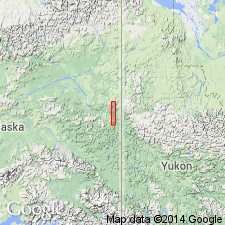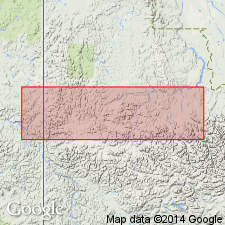
- Usage in publication:
-
- McCann Hill Chert*
- Modifications:
-
- Named
- Biostratigraphic dating
- Dominant lithology:
-
- Chert
- Shale
- Limestone
- AAPG geologic province:
-
- Alaska East-Central region
Summary:
Named for exposures on McCann Hill. Type section is along creek about 0.5 mi east of Benchmark 4085 except for uppermost 100 ft which is exposed on ridge crest extending north, east-central AK. Traced from Canadian border near McCann Hill to Montauk Bluff on Yukon River. Consists of 200- to 800-ft thick sequence of thinly bedded light-gray to black chert and siliceous shale, with few interbeds of siltstone and chert grit, and a limestone and shale member at its base. Disconformably overlies Road River Formation. Conformably underlies Nation River Formation. Abundant fossils indicate age of unit ranges from earliest Middle Devonian (Eifelian) at its base to Late Devonian in its upper part. (List of fossils included.)
Source: GNU records (USGS DDS-6; Menlo GNULEX).

- Usage in publication:
-
- McCann Hill Chert*
- Modifications:
-
- Age modified
- Biostratigraphic dating
- AAPG geologic province:
-
- Alaska East-Central region
Summary:
Limestone and shale basal member of McCann Hill Chert is Emsian Age (late Early Devonian) based on ostracodes, bryozoans, trilobites, brachiopods, pelecypods, conodonts, and tentaculitids obtained from type area. [Therefore, overall age of whole unit is Early to Late Devonian based in part on earlier studies of unit's upper part.]
Source: GNU records (USGS DDS-6; Menlo GNULEX).
For more information, please contact Nancy Stamm, Geologic Names Committee Secretary.
Asterisk (*) indicates published by U.S. Geological Survey authors.
"No current usage" (†) implies that a name has been abandoned or has fallen into disuse. Former usage and, if known, replacement name given in parentheses ( ).
Slash (/) indicates name conflicts with nomenclatural guidelines (CSN, 1933; ACSN, 1961, 1970; NACSN, 1983, 2005, 2021). May be explained within brackets ([ ]).

